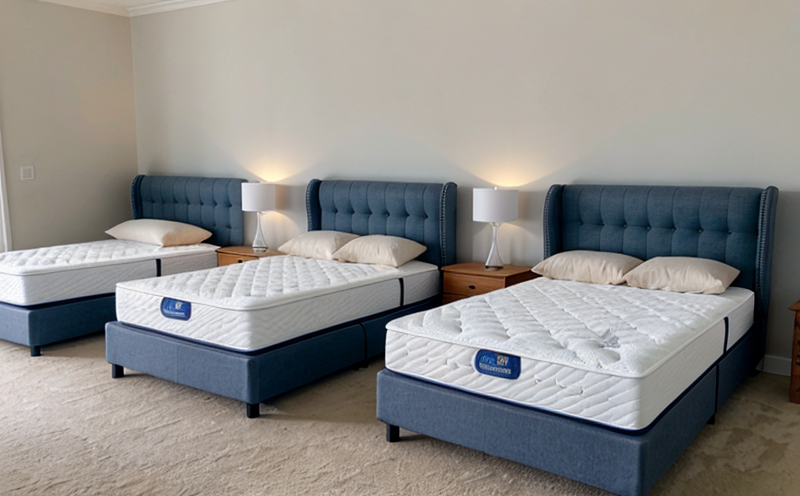BS EN 1334 Bed Dimensions and Mechanical Safety Testing
The British Standard (BS) EN 1334 is a crucial document that sets out detailed requirements for the dimensions, mechanical safety, and performance of beds and mattresses. This standard ensures that products meet essential quality and safety criteria before they reach consumers. Compliance with BS EN 1334 is mandatory in many countries within Europe to ensure that beds are safe, durable, and fit for their intended use.
This testing service covers a wide range of aspects including the measurement of bed dimensions as specified in the standard, ensuring that all parts of the bed comply with size requirements. This includes headboard, footboard, side rails, and any other components. The mechanical safety tests focus on identifying potential hazards such as sharp corners or protrusions which could cause injury.
During the testing process, we use specialized equipment to ensure accuracy. For instance, digital calipers are used for precise measurement of dimensions while load testers replicate real-world pressures a person might exert when sleeping or using the bed. These tests simulate various scenarios that a user may experience during their interaction with the product.
The results from these tests provide critical information about whether or not a particular design meets the standards set forth by BS EN 1334. Compliance with this standard also helps manufacturers to avoid costly recalls and potential legal issues associated with non-compliant products. By adhering strictly to these guidelines, businesses can demonstrate their commitment to producing safe and high-quality furniture.
Understanding how to interpret compliance data is essential for companies operating in the bedding industry. It allows them to make informed decisions regarding product development and manufacturing processes. Additionally, understanding what constitutes non-compliance helps prevent potential issues early on in the production cycle, thereby saving time and resources later down the line.
In conclusion, ensuring compliance with BS EN 1334 is not just a requirement but an opportunity for furniture manufacturers to enhance their reputation among consumers who value safety above all else. Through rigorous testing procedures outlined in this standard, companies can create products that are both safe and reliable – qualities highly appreciated by those looking to invest in durable home furnishings.
Scope and Methodology
The scope of BS EN 1334 covers the dimensions and mechanical safety aspects of beds and mattresses. It specifies requirements for ensuring that these products are safe, functional, and meet specified tolerances in size. The methodology involves several key steps:
- Measurement of critical dimensions using precision tools.
- Application of loads to simulate actual use conditions.
- Inspection of materials and construction for any defects or weaknesses.
Detailed records are kept throughout the testing process, including photographs and measurements. This documentation serves as evidence that all tests were conducted according to standard procedure. Compliance with BS EN 1334 ensures not only regulatory compliance but also enhances brand reputation by demonstrating a commitment to quality and safety.
For manufacturers involved in producing beds or mattresses, understanding these requirements is crucial for effective product development and production. By following the outlined procedures precisely, companies can ensure their final products are safe and reliable, thus gaining consumer trust and loyalty.
Environmental and Sustainability Contributions
Compliance with BS EN 1334 contributes positively to environmental sustainability by promoting safer and more durable furniture. Safe beds reduce the likelihood of accidents, leading to fewer injuries and reduced medical costs associated with improper product use.
Durable products made in accordance with this standard last longer, reducing waste and resource consumption over their lifecycle. This extended lifespan also means less frequent replacements, which further minimizes environmental impact by decreasing demand for new materials.
Manufacturers who adhere to these standards benefit from enhanced reputations among environmentally conscious consumers. They can position themselves as leaders in sustainable practices within the furniture industry, attracting customers who prioritize eco-friendly choices.
In summary, compliance with BS EN 1334 plays a significant role in fostering environmental responsibility while maintaining high levels of product quality and safety. By adhering to these stringent requirements, businesses contribute effectively towards creating healthier living environments for everyone.
Competitive Advantage and Market Impact
- Increase in Sales: Meeting international standards like BS EN 1334 can significantly boost sales by increasing consumer confidence. When shoppers know that your products meet stringent safety regulations, they are more likely to purchase from you.
- Better Brand Image: Companies that comply with such rigorous standards often see an improvement in their brand reputation. This enhanced image attracts not only existing customers but also new ones looking for trusted brands.
- Market Expansion: Adherence to global standards opens up opportunities for expanding into new markets where these regulations are enforced. It gives businesses a competitive edge over competitors who may not meet these requirements.
Furthermore, compliance with BS EN 1334 can lead to cost savings in the long run through reduced warranty claims and fewer product recalls. These measures help maintain customer satisfaction while minimizing financial losses due to defective products.
Overall, meeting the stringent criteria set by BS EN 1334 provides substantial benefits that extend beyond mere compliance. It enhances your position as a leader in your market segment and fosters trust among consumers worldwide.





